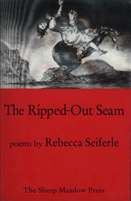|
It's one of those inexplicable moments where you are at a
loss for words and the simple task before you remains undone:
Write up a book review. But it can't be done when you have
the magnitude of the river pressing down on you. It occurs
to you, that is exactly how one goes about describing The
Ripped Out Seam by Rebecca Seiferle. Her poems run by,
at you in torrents, in a rush of words, rapid and seething.
One single word tossed into the river ripples across the surface
and sinks in deeply. But that's not where it settles. It's
dug up again, tossed around, turned over and scrutinized until
it takes on the shape and properties of stone, a rock, leaving
a wound where a word was dug out. The book itself, a seamless
river of stones, reader beware.
The Ripped-Out Seam, being one of Seiferle’s
earlier collections absolutely blew me away. I mean there
is no question about the beauty and precision of this book
in its entirety. I’ve read through this book twice and
each time I couldn’t think of one poem that I felt was
inserted as merely “filler”. What impressed me
most about the poems in this book was how concise the language,
the lack of any romantic element (even in Allegory of Love)
and the depth of pathos so many of her poems invoke with such
a gripping force. A few of my favorites would include, “The
Body Politic”; “Twelve Theorems of Desire”;
“The Fear of Irrational Numbers”; “A for
Anathema”; “The Seizures” and “Bat
in a Jar.”
In the poem, “The Seizures” about a young classmate,
the poem jumps in with:
"Staring intimately into/her face-her tongue beginning
to twitch” the symptoms progress until the reader is
literally “pinned/to the floor, first by her own convulsing,/then
by the teacher’s panic and our limbs/recruited to hold
her down, she shut her eyes” and just as you begin to
breathe, the poem ends on these haunting lines:
How could I not look at her? Not one
Of us could look away. When her convulsed gaze
Finally came into focus
What she pitied was us.
Here the poem makes the reader aware of how fragile the human
is, when one’s own body revolts, and those who would
hold her down against her own will reminded me so much of
the young ewe in “Vocabulary” when its throat
is cut "because when they are dying,/we do not want to
hear them scream.”
Then in “A for Anathema” these priceless lines
are worth the price of an entire book:
Tell me, what kind of world is this
where one woman can buy new sheets
and tear them to braid
into the tails of her horses
and another woman has to sleep,
unconscious on pavement, curled
against a fence?...
But exactly what makes The Ripped-Out Seam worthy of a Pulitzer
Prize? Surely a book of this magnitude is more than “New
Mexican, with a place in American Poetry”. Yes, granted
that many of Rebecca’s poems center on Southwestern,
or Native American themes, but the scope of this book as well
as her other two books are more universal in nature, an intensely
powerful statement of the human condition.
Bat in a Jar
The jar was a mason jar, made to preserve
apricots and stone cherries and to withstand
the extremes of cold air and hot water baths
where the steam, rising, lifts
the canner’s black lid
only to drop it, hissing, again. And the bat,
trapped inside knew, if it knew anything,
it would never escape, though
the sky kept humming
with insects and the orchards darkened
as usual, apparently the same.
Someone had put the bat in a jar—to avoid
bites and disease or to protect
the bat itself from house cats and dogs?
In any case, the bat kept calling
for rescue, measuring what confined it, trying
to scale the horizon, that sky of glass. But though
the bat’s ears shaped themselves
to the echo, though the echo
filled the glass, the jar parodied
the bat’s longing and gave back
nothing of itself.
Mirrored, only the bat was mirrored. Its fear
inaudible except to itself, confined
to its own mind. That which enabled
the bat to select a mosquito
or to nip a June beetle out of the air
now sickened it. Open-mouthed,
wings beating hopefully, hopelessly, the bat
lifted its wing like one seamless membrane
and again and again
tried to answer.
When I first read this poem, everything around me became
muted. I heard nothing, I put the book down stunned. I was
so affected that my hands shook when I picked up the book
and read it again. Now, I can’t read this poem without
crying. Why? How does this happen? There’s no mention
of blood, no violence, no startling metaphor, or loud imagery
splashed against the white canvas of this poem. There are
no superlatives, or alliteration, or jarring beat pounding
out some ominous message. Transference takes place: we, you
and I, become the bat and all of sudden we find ourselves
trapped in this glass jar. The psychological implications
that we could be so trapped in our own minds is so devastating
as to evoke a type of fear, paralysis within ourselves. This
is the type of writing that makes Ripped-Out Seam impossible
to put down and simply impossible to forget.
Copyright © 2004 Tryst3.com.
All Rights Reserved. |


